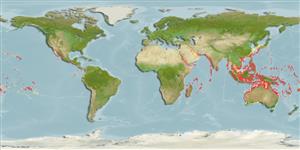Common names from other countries
Classification / Names / Names
Populärnamn | synonymer | Catalog of Fishes (gen., sp.) | ITIS | CoL | WoRMS
Environment: milieu / climate zone / depth range / distribution range
Ekologi
; djupintervall 1 - 50 m (Ref. 100964). Tropical
Indo-Pacific. The form occurring from the Red Sea to the Gulf of Oman is usually distinguished under the name Cerithium erythraeonense.
Length at first maturity / Size / Vikt / Age
Maturity: Lm ? range ? - ? cm Max length : 15.0 cm SHL hane/ej könsbestämd; (Ref. 349); common length : 12.0 cm SHL hane/ej könsbestämd; (Ref. 349)
Commonly collected in the Indo-West Pacific, for food and shell trade (Ref. 349). Usually near the outer edge of reefs (Ref. 349). Also found on open reef flats (Refs. 799, 75835).
Life cycle and mating behavior
Könsmognad | Reproduktion | Lek | Ägg | Fecundity | Larver
Members of the order Neotaenioglossa are mostly gonochoric and broadcast spawners. Life cycle: Embryos develop into planktonic trocophore larvae and later into juvenile veligers before becoming fully grown adults.
Poutiers, J.M. 1998. (Ref. 349)
IUCN Red List Status (Ref. 130435)
CITES status (Ref. 108899)
Not Evaluated
Not Evaluated
Threat to humans
Harmless
Human uses
Fiskeri: kommersiell
| FishSource |
Verktyg
Ytterligare information
Age/SizeTillväxtLength-weightLength-lengthMorfologiLarverAbundans
Internet-källor
Estimates based on models
Preferred temperature
(Ref.
115969): 24.5 - 29, mean 28 (based on 1108 cells).
Vulnerability
Low vulnerability (10 of 100).
Price category
Unknown.
